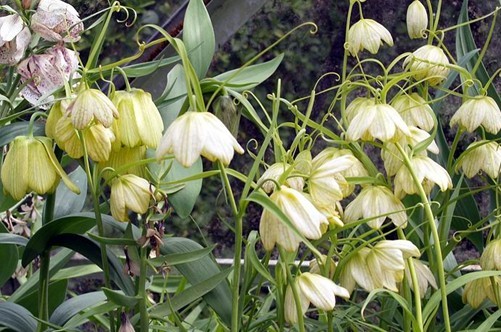Natural Products
Fritillaria thunbergii Miq.
Fritillaria is a genus of about 100 species of bulbous plants in the family Liliaceae, native to temperate regions of the Northern Hemisphere. The name is derived from the Latin term for a dice-box (fritillus), and probably refers to the checkered pattern, frequently of chocolate-brown and greenish yellow, that is common to many species' flowers. Collectively, the genus is known in English as fritillaries; some North American species are called missionbells.
Most fritillaries contain poisonous alkaloids such as imperialin; some may even be deadly if ingested in quantity. But the bulbs of a few species – e.g. Checker Lily (F. affinis) or Yellow Fritillary (F. pudica) – are edible if prepared correctly. They are not generally eaten in large amounts however, and their edibility is therefore still somewhat debatable.
Most fritillaries contain poisonous alkaloids such as imperialin; some may even be deadly if ingested in quantity. But the bulbs of a few species – e.g. Checker Lily (F. affinis) or Yellow Fritillary (F. pudica) – are edible if prepared correctly. They are not generally eaten in large amounts however, and their edibility is therefore still somewhat debatable.
Fritillaria is also used as an herb in Traditional Chinese Medicine, known by the Chinese name Chuan Bei Mu, Bulbus Fritillariae Cirrhosa.
Research products of Fritillaria thunbergii Miq.
| Catalog | Product Name | CAS Number | Manual |
|---|---|---|---|
| CFN98144 | Peimisine | 19773-24-1 | |
| CFN99711 | Sipeimine | 61825-98-7 | |
| CFN99990 | Tubeimoside I | 102040-03-9 | |
| CFN99996 | Peimine | 23496-41-5 | |
| CFN99997 | Peiminine | 18059-10-4 | |
| CFN99916 | Beta-Sitosterol | 83-46-5 | |
| CFN98117 | Beta-Carotene | 7235-40-7 | |
| CFN90475 | Hupehenine | 98243-57-3 | n/a |
Screening Libraries
Artemisia annua L.
A unique collection of 25 natural compounds from Artemisia annua L.
A unique collection of 25 natural compounds from Artemisia annua L.
Andrographis paniculata (Burm. f.) Nees
A unique collection of 29 natural compounds from Andrographis paniculata (Burm. f.) Nees
A unique collection of 29 natural compounds from Andrographis paniculata (Burm. f.) Nees
Lycium barbarum
A unique collection of 24 natural compounds from Lycium barbarum
A unique collection of 24 natural compounds from Lycium barbarum
Astragalus membranaceus ( Fish ) Bunge var. Mongholicus (Bunge) Hsiao
A unique collection of 23 natural compounds from Astragalus membranaceus ( Fish ) Bunge var. Mongholicus (Bunge) Hsiao
A unique collection of 23 natural compounds from Astragalus membranaceus ( Fish ) Bunge var. Mongholicus (Bunge) Hsiao
Psoralea bituminosa L.
A unique collection of 23 natural compounds from Psoralea bituminosa L.
A unique collection of 23 natural compounds from Psoralea bituminosa L.





